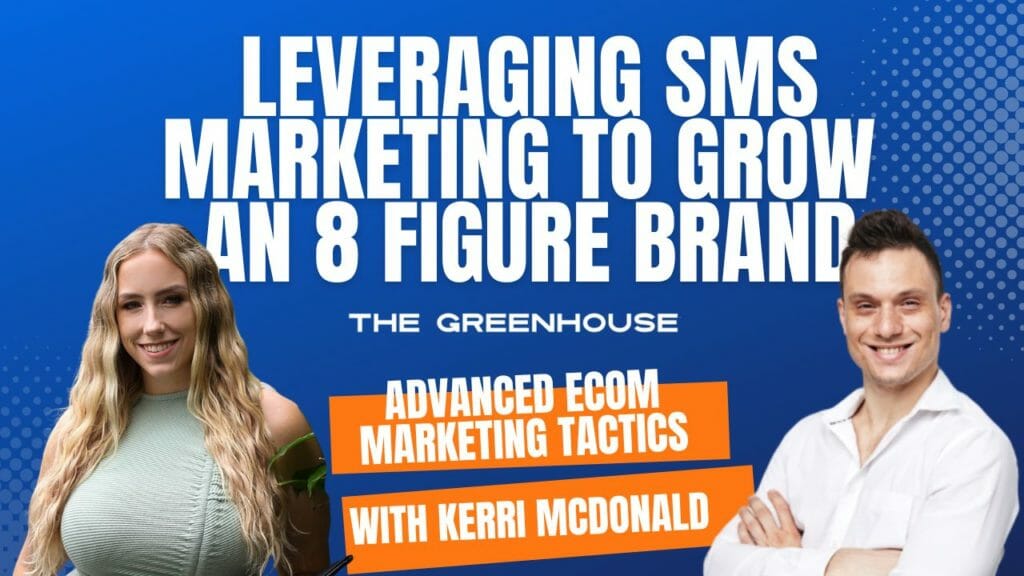Podcast: Play in new window | Download (Duration: 41:38 — 38.1MB)
Subscribe: Apple Podcasts | Spotify | RSS
Introduction
Hi, e-commerce friends. Let me introduce you to Kerri McDonald, who was the speaker at Ad World Conference in 2022 and invited to speak there this year. Kerri dove head-first into e-commerce over four years ago, driving her first brand to eight figures status as a director of marketing in less than three years. She co-founded The Greenhouse with her partner in 2020. Centered on e-commerce, email and SMS marketing, The Greenhouse has quickly grown into an agency where clients take root and flourish, generating over 10 million in revenue for its brands and the first year. Kerri, welcome to the show.
If you want to connect with Kerri, we have a Facebook group. Kerri will be also part of that group. And this is only for e-commerce owners so feel free to join us.
Highlights
So I would say if you’re just looking into getting started into SMS, I would definitely focus on making sure you have a strong email list first. If you don’t have a strong email list and a strong email channel, then it doesn’t make sense to pick up another channel that requires more of your attention and more of your strategy. (8:25)
Best practices, number one, focus on growing the list. Because you’re only going to be as successful as you’re growing the list. So when I say build your email list first and then leverage the email list to try to get them into an even deeper form of your community. So if they’re already in your email list, try to get them on your SMS list as well. (13:30)
So how are you acquiring leads and customers? So acquisition is the first step in the journey. And then you have conversion, how are you converting those customers? And then you have retention, how are you retaining those customers? So you have these three buckets, and the thing is that all three buckets need to be strong. There are different channels that help with each bucket. (23:15)
The Beginnings
I’ve been in the e-commerce space now for about five years. Five years ago, I was a teacher. But while I was a teacher, I realized it wasn’t the right career path for me. But I was always a very creative person so, when I had time off, when I was teaching, I taught myself graphic design and I started an Etsy shop. And those skills landed me a position in graphic design at an e-commerce company.
I was able to transition there. Working for an e-commerce startup, there’s a lot of opportunities for growth, learning, etc. I really took that opportunity about three months in. I was designing the emails and then I started sending the emails, and then moved my way up into the company and eventually became director of marketing and the brand grew to eight figures, nine figures, pretty quickly.
It was a really good experience in e-commerce, just being director of marketing for a large brand for three years, managing agencies, managing a marketing team, building the tech stack, everything like that. Getting hands-on experience with a brand was by far the best way that I was able to learn about marketing and learn about e-commerce in general, just learning what a brand goes through on the inside.
After that, I was working with the company and I’ve always had an entrepreneurial spirit, starting my own Etsy shop even back in the day. I’ve just always wanted to pave my own path and I knew I had it in me. While I was working with the e-commerce company, my co-founder, who’s also my boyfriend, my business and life partner, we started a clothing company and we just wanted to try that out on our own to see how it worked and what the logistics were, building it on our own. But then we were met with some challenges with COVID and the supply chain, and we couldn’t get the product. We pivoted to the agency space because I knew email and SMS really well.
And so we said, “All right, if e-commerce is going to be difficult right now during COVID, maybe we can pivot to a position of helping e-commerce businesses.” We knew we wanted to be involved in e-commerce. So at that point, we just learned and developed for eight months to almost a year. Then, we finally dove into the agency and we’ve been doing it full-time now for almost two years. We’ve worked with over 30 brands, generated 50 plus million in email and SMS revenue. It’s been amazing.
Greenhouse and its Clients
The Greenhouse works with, we say e-commerce brands, but at this point we like to work with brands who we really enjoy; the product, the mission, and the market positioning, brands that are fun to market for. Pretty much everyone on the team are avid shoppers. We love to shop and we love retail, so we love products that we’re passionate about marketing for. We love working with beauty brands, food and beverage brands, fashion and apparel brands. E-commerce brands with a 20K list size making over a million a year are generally who we’re looking for, and who we can tell have a really good chance of success and probably have a lot of gaps in their email and SMS marketing.
Ideal Client
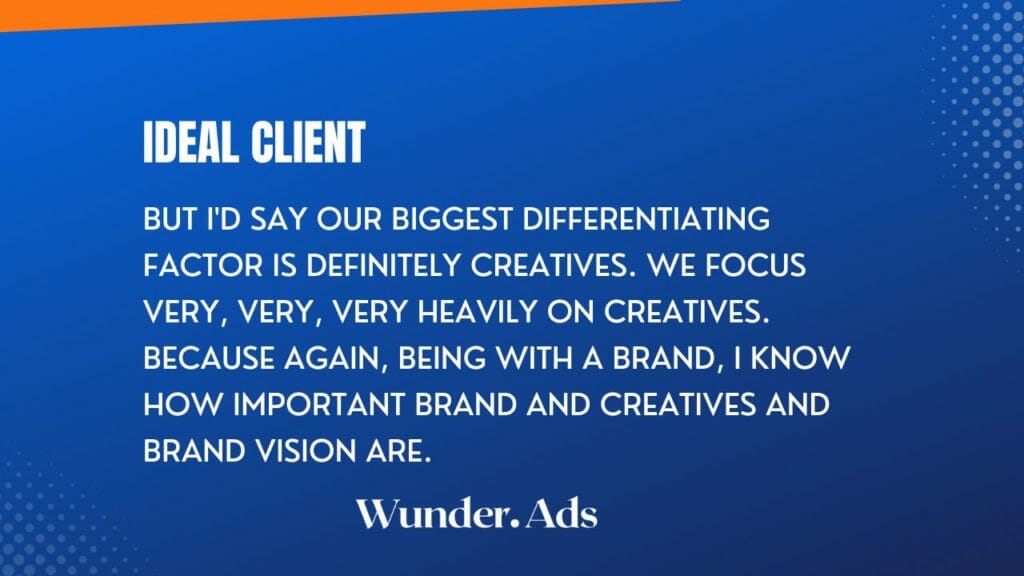
The barrier to entry got very low over the years. You have people who take a course and then start an agency. Me personally, being the director of marketing for a brand, being able to lead the marketing team, oversee the agencies and manage the agencies. I managed agencies on my own in an e-commerce brand, so I knew what I liked about the agency, what workflow was good for us, what workflow was not good for us, those types of things.
Just being in it, I was able to learn what level of service brands should get versus what they shouldn’t get. Having that inside experience was able to help us tailor a custom experience that we offer now. But I’d say our biggest differentiating factor is definitely creatives. We focus very, very, very heavily on creatives. Because again, being with a brand, I know how important brand and creatives and brand vision are. We focus very heavily on bringing on really strong design and copy talent that can bring the brand’s vision to life visually and through words. That’s our biggest differentiating factor, the creatives. It’s something that we focus on and are constantly developing and making better.
SMS Marketing
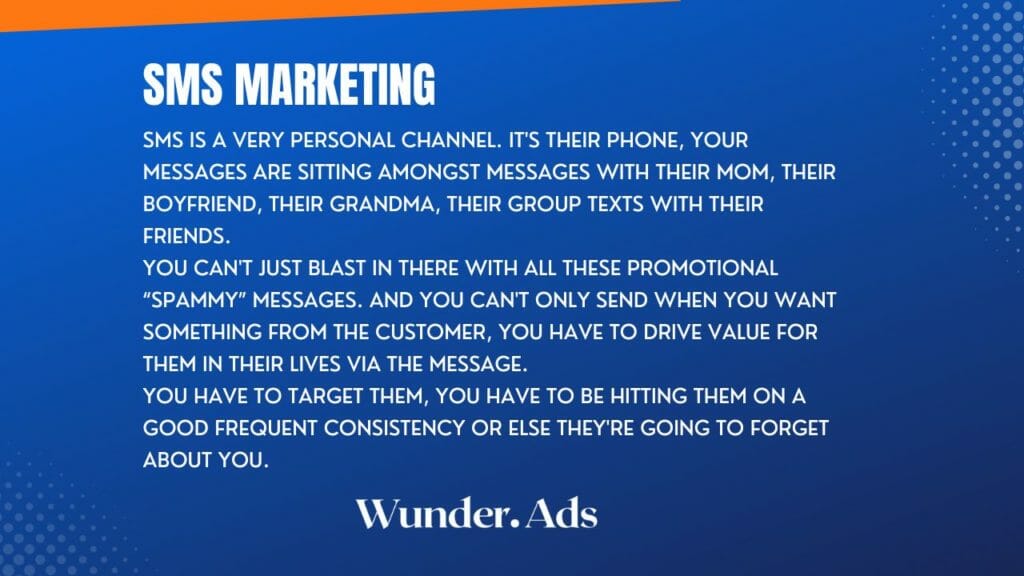
SMS marketing is just an additional channel for any e-commerce brand. You have all the channels and they’re all important, but they’re not all important at every stage for every brand. It’s figuring out when SMS makes sense for you. If you’re just looking into getting started with SMS, I would definitely focus on making sure you have a strong email list first. If you don’t have a strong email list and a strong email channel, then it doesn’t make sense to pick up another channel that requires more of your attention and more of your strategy.
It just doesn’t make sense if your email list is only at 2K and you only have so many people interested in what you are selling via email, then trying to pick up another channel like SMS. You’ll probably get started, maybe see some quick results, and then maybe you might scale back, you might get discouraged. So, build a strong email channel, 20K plus, and then start to think about SMS.
The other thing when starting SMS is, SMS is a very personal channel. It’s their phone, your messages are sitting amongst messages with their mom, their boyfriend, their grandma, their group texts with their friends. You can’t just blast in there with all these promotional “spammy” messages. And you can’t only send when you want something from the customer, you have to drive value for them in their lives via the message. You have to target them, you have to be hitting them on a good frequent consistency or else they’re going to forget about you.
The problem is that brands open up SMS and they send one or two texts a month. If I’m only hearing from you once a month, in those 30 days I’ve forgotten about you. I’ve forgotten what you do, why you’re relevant to me. And I’m going to unsubscribe quicker when I get that second text. It’s much better to have a smaller list, talking to them frequently and driving high value for them. So if you don’t feel like you have the space or the knowledge to be able to create a program like that, then don’t get started with it. It should be intentional.
I got started with SMS five years ago, and I have used every SMS provider, all of the major SMS providers that there are, Klaviyo, Postscript, Emotive, Attentive… I have used all of them. I personally have a favorite out of those that I use because deliverability is strong, the UX is very strong on the platform. And for me, Klaviyo got into the game a little bit late with SMS. And in terms of a deliverability standpoint and the UX for SMS, I feel like it lacks.
Personally, I don’t see the value so much of having them in the same space. As long as you’re intentional about the strategy, if you use a good platform, you can upload Klaviyo segments into your SMS platform. You can figure out how you’re targeting the different times on a flow chart and then just build them separately and into different platforms. I don’t see the value in using the same platform yet, just because I haven’t found a platform that does both equally the same at the same level.
My personal favorite is Attentive, so that would be my pick. But I have used Postscript, it’s an option for smaller brands. It’s not personally my favorite. Attentive and Postscript are probably the only two I’d recommend at this time.
SMS Marketing Tips and Tricks
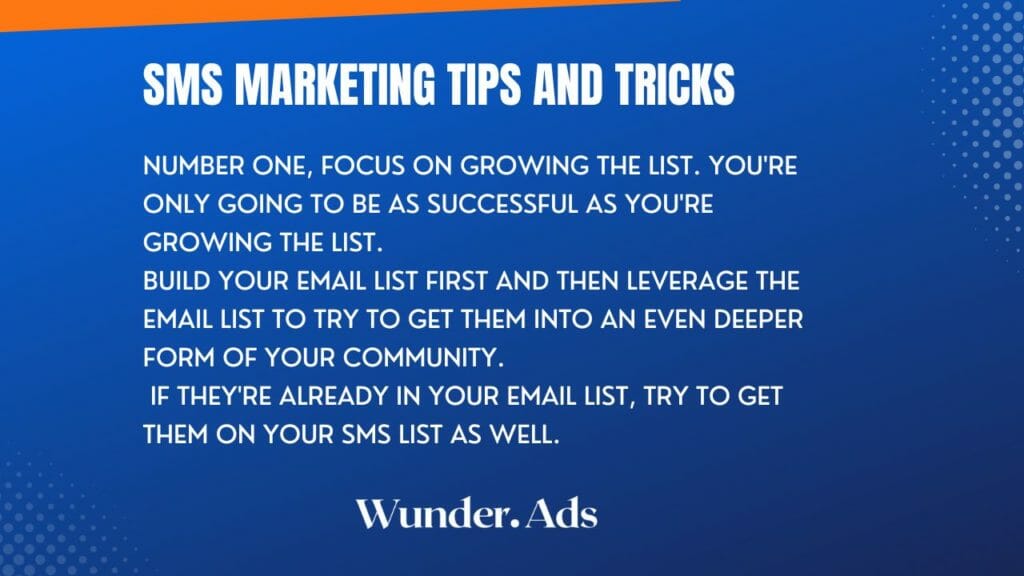
Number one, focus on growing the list. You’re only going to be as successful as you’re growing the list. Build your email list first and then leverage the email list to try to get them into an even deeper form of your community. If they’re already in your email list, try to get them on your SMS list as well.
If you build up a strong email list, you should already have 20, 30, 50, 80,000 people that you can turn to and say, “Hey, we have this SMS. If you join it, you’re going to become a VIP. You’re going to get exclusive updates, discounts, launches, et cetera.” And it’s also a more two-way communication channel, so you can encourage them to respond via SMS, as well. So you already have those people to turn to. And then using social media is a good way to leverage building the list.
Once you’re building the list, you can test more things and figure out what’s working for the channel. But if you only have a few hundred, a thousand subscribers on SMS, it’s hard to figure out what’s really working or it’s hard to keep those people engaged and always involved. I’d say, try to grow the list as rapidly as possible and just be intentional with the strategy.
Talk to them as if they’re human beings. Don’t just say, “Sale, sale, sale.” I got a text from Glossier last week and it was on a Friday, and it said, “Hey, just a reminder, you’re doing amazing. Also, don’t forget to wash your face.” I loved it. I stick around for the value and the smile that the texts bring onto my face.
SMS Marketing: How not to be Salesy
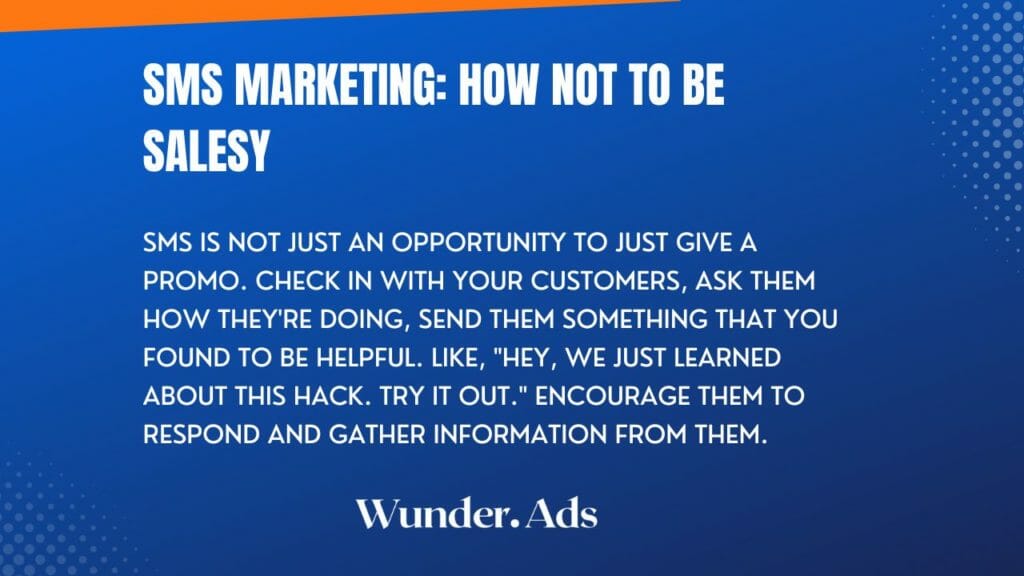
SMS is not just an opportunity to just give a promo. Check in with your customers, ask them how they’re doing, send them something that you found to be helpful. Like, “Hey, we just learned about this hack. Try it out.” Encourage them to respond and gather information from them.
Also, you can send gifts and videos via SMS. While they do cost more, it can be really effective if there’s a good strong influencer video with a really good how-to that you want to share, or a message from the founder, or even just a gift that’s funny and relatable or an animal picture. The funny thing that people don’t realize is, sometimes it’s not a discount that people need to purchase. They might just need a reminder. They might just need to remember that you’re there, remember that you have a certain product that they need. Don’t always just turn to discounting to get a quick sale.
Optimizing SMS Marketing
One of the things that we tested a lot was image versus no image, because all the platforms will tell you all the things to do that are going to benefit them. When you send an image in your text message, it costs more to you, which means more profit for the company that’s sending your SMS. So of course they’re going to say, send an image.
But we’ve tested this extensively and actually found that images in SMSs don’t actually provide a high enough revenue or engagement lift to justify the price, because it feels like an ad in the text message, especially if it’s a designed graphic. It looks like basically you took an ad from social media and you put it in their text messages, versus if you would send them a dog picture or a cat picture that would make them laugh, that would be an acceptable way to use an image, not just a marketing image.
But a lot of the opportunity does come from the flows and automations. The same way that you set up flows and automations on email, you can set those up on SMS. I’d say nine times out of 10, when I’m looking at accounts to optimize and how to make them even better, even if they’re already running, I’d say that’s where I see the most opportunities, by setting up automations. Because when you put focus into setting up your automations, you have things that are running on the backend continuously, always, that you don’t have to keep manually setting up yourself. Automations can be really strong and a way to build more of those.
SMS and Email Marketing Platforms
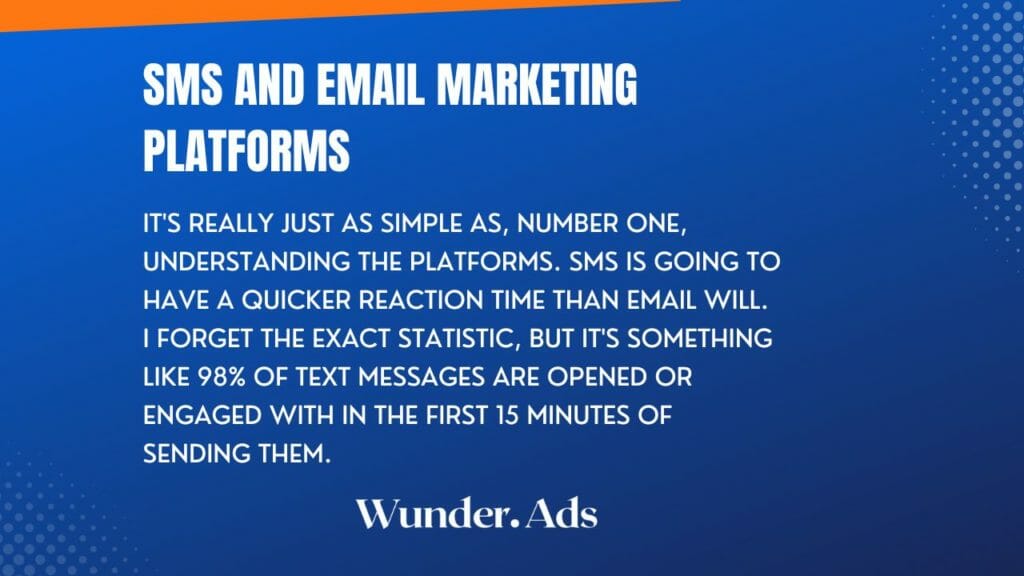
It’s really just as simple as, number one, understanding the platforms. SMS is going to have a quicker reaction time than email will. I forget the exact statistic, but it’s something like 98% of text messages are opened or engaged with in the first 15 minutes of sending them. And then after that, the campaign life cycle dies down. Whereas an email can sit in somebody’s inbox for hours, even a day or days sometimes, and then they go back and they read it. People don’t have the same reactiveness with email as they do with SMS.
It’s really just understanding that, knowing that, okay, SMS is a quicker and faster way to get to them, email is a little bit longer play. And then setting up the right triggers and filters in place to make sure they lead if they take the action that you want them to. Let’s say you have an abandoned cart automation and you’re trying to leverage both email and SMS. I mean, one important thing to remember is that in SMS you’re only allowed to send one text message. It’s the law now with the texting, the carriers put that out.
It doesn’t take much thought process to say, “Okay, I have one SMS to send, and then I have an email flow that I can build.” And all I have to do is trigger, differentiate the timing so that they’re not getting the messages at the same time. So we say, “Hey, send the first text message for an abandoned cart at 20 minutes.” 20 minutes, they’ve just taken the action, they’ve gone about their day. We give them a little bit of time, a little bit of breathing room, but we just nudge them like, “Hey, don’t forget you were almost about to do a good thing. Finish that.”
And then, 20 minutes, you have on your email side of things, if they didn’t make that purchase, then they get an email a couple hours later. If they didn’t purchase, then they get an email the next day. So it’s really just what I like to do when I’m thinking about email and SMS together. If I’m trying to build a really complicated workflow where I don’t want there to be overlap in timing, I will use something like a mural board or a flow chart, I’ll build out on a flow chart visually and think about the timing there. And then I just go to the platforms to actually build and execute.
Growing an Email List
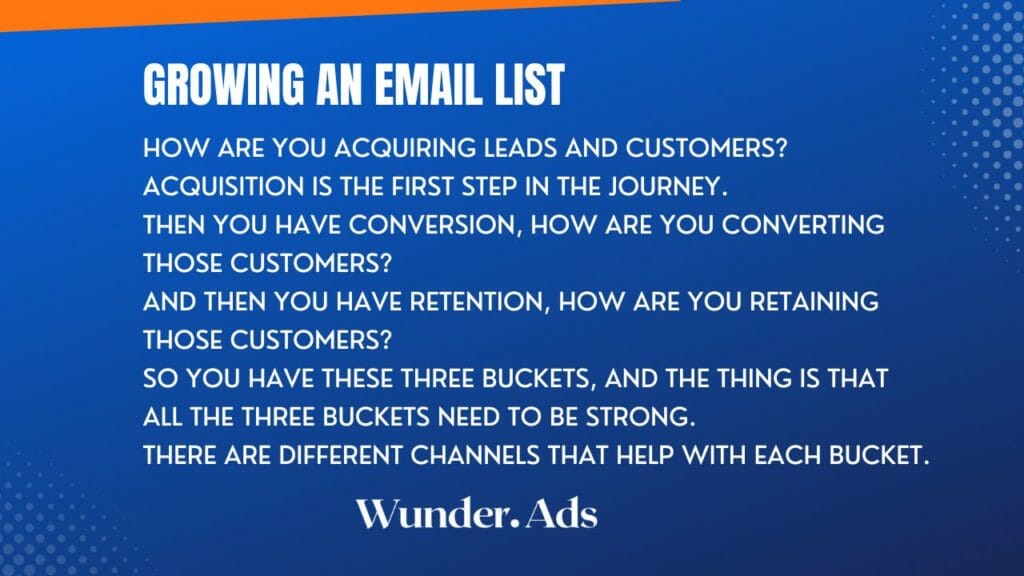
Definitely. I’ll start this answer by saying that there’s three really important buckets that you do need to focus on in e-commerce, I guess really in any business in general, but I speak on e-commerce, so that’s what I share.
You have your acquisition bucket. How are you acquiring leads and customers? Acquisition is the first step in the journey. Then you have conversion, how are you converting those customers? And then you have retention, how are you retaining those customers? So you have these three buckets, and the thing is that all the three buckets need to be strong. There are different channels that help with each bucket.
When you ask about growing the email list, it’s important that your acquisition efforts are strong. You need to constantly be bringing people into your website, into your funnel, into your world of the brand, so that they can even find out about you and get interested in what you’re trying to do. That’s step one. It’s not just organic social, it’s not just blog writing, it’s not just SEO. It’s not just YouTube, it’s not just TikTok, it’s not just ads. It’s all those things combined to bring in different people from different channels onto the website or into a landing page.
Once you get those, once you have strong acquisition efforts flowing into a website or a landing page, then hitting them with pop-ups to build the email list. On average, on a very high end, you can see your pop-up maybe having an opt-in rate of 10%. That’s on a very high end. That means 10% of the traffic coming to your website or your landing page is going to sign up to your email list. That’s a low number when you think about how much traffic you’re driving. But it gets even scarier because when I see most brands, when I open up their efforts, I see that they’re at a three to 5% opt-in rate.
So, number one, how much are you driving on the acquisition side? And then number two, when they get there and you have that pop-up, is the pop-up enticing enough? Is the offer enticing enough for them? Is it hitting them at the right time when they get to the website? Does it have the right copy, the right visuals? Those are all things that really need to be tested over time. But having a pop-up or two on the website is definitely important for growing the list.
And then additionally, same way for SMS, using your social media and putting a landing page that collects both email or SMS, let’s say on your pinned stories on your Instagram or in your link in bio on TikTok. Having that at the top, getting them on the list from those channels is a good way as well to grow the list.
I certainly don’t recommend a lot of giveaways. You could try co-branded giveaways with other brands that are in your same niche. But the problem with giveaways is that you get people who just want free things and they’re not really going to be interested buyers with you or with the brand. And then similarly, I definitely don’t recommend buying lists from anywhere. It can hurt more than it can help, I’ll just say that. Just focus on organic ways of growing the list.
Segmenting Different Audiences
I’d say, once they’re on the list, it’s important to segment based off of engagement mainly. When you’re on each platform, if you’re on Instagram, you’re optimizing for Instagram performance. If you’re on TikTok, you’re optimizing for TikTok performance. If you’re on the email channel, you need to optimize for email engagement. And the way to do that is to target people who are actually engaging with your emails, people who are opening and clicking your emails.
If you have customers who are on your email list and have received 10 to 20 emails and never opened and never clicked, just exclude them. They’re what we call dead weight. They’re just not valuable to your list. They’re going to drag your metrics down. Segmenting by engagement once they’re on the list is very important. And then for us, we use a form of RFM segmentation. RFM stands for recency, frequency, and monetary value. We’re basically splitting customers up based on how recently they engaged with the brand, how frequently they’re engaging with the brand, and at what monetary value.
In there, you can tell if you have a customer who’s engaged recently and frequently, but no monetary value, then those people are potential buyers. They’re very close to purchasing. They’re engaging frequently, very recently, but they haven’t bought yet. Versus somebody who is not engaging recently or frequently and they have no monetary value, they’re really not that interested. So no need to target them as much. And if you do, only try to give them something that you think is going to make them convert, a sale, a new launch, something.
By using the RFM segmentation, if they’re engaging recently and frequently with the brand, they’re more inclined to make an impulse purchase not using a discount. Especially if somebody signs up for your email list and you give them a discount. Many times people will give that 10% discount on their welcome offer.
But what will happen is, a lot of people will impulse buy from that, right? Okay, I get an offer, I sign up, I get the code, I’m going to impulse purchase. Now you need to look at the people who didn’t actually impulse purchase from that. Either, number one, they’re not discount-driven, meaning they need more information or background, or they need something more from you to convince them to purchase. Or they just want a higher discount.
And I will say this with caution, building a brand only based on discounts can only hurt your profit margins in the long run. And the more you train customers to only wait for a discount, you’re never going to be able to sell anything full-price, and it’s going to completely cheapen your brand. And if that’s what you’re going for, cool. But if you’re really trying to build a brand over time, find the customers that are willing to pay for your product full price, that are more likely to keep coming back and keep buying from you, and it won’t cut into your profit margin.
To answer your question, how do you convert a warm lead versus a cold lead? If they’re a warm lead and they have already gotten that welcome offer and it didn’t make them convert, then start thinking about other ways. A lot of people I see aren’t using things like UGC and social proof and reviews in their emails.
It’s a huge way to push. So we push a lot of that, Instagram photos, reviews, press, things like that in the emails for those people. And usually press UGC reviews are what makes them convert. Versus somebody who’s a colder lead at this point, they’re telling you, “Hey, I got your welcome discount. I’m not interested. I got your next selling proposition. I’m not interested.” You can try to get them with a little bit of a higher discount or combine it with free shipping, or give them a special bundle. But again, then at some point you’re just giving so much away for a customer that likely won’t return and won’t stay with your brand because they’ll jump ship the second they find a cheaper product somewhere else.
Design and Email Marketing
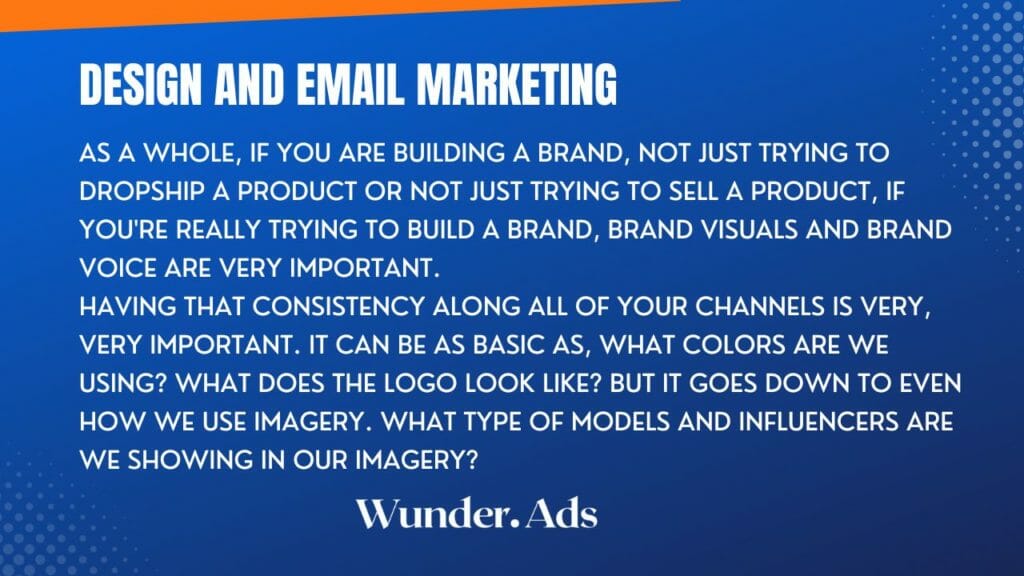
As a whole, if you are building a brand, not just trying to dropship a product or not just trying to sell a product, if you’re really trying to build a brand, brand visuals and brand voice are very important. Having that consistency along all of your channels is very, very important. It can be as basic as, what colors are we using? What does the logo look like? But it goes down to even how we use imagery. What type of models and influencers are we showing in our imagery?
A good example of this is only using models who are thin and blonde versus using models of all different shapes, sizes and colors. Even that is branding. When you look at, let’s say Victoria’s Secret for example, I think most people still associate them with the skinny blonde model Angel. And so that’s very much their branding and their brand positioning that they have put out over the years.
And similarly to what models and influencers you’re showing, the copy that you’re using, is it relatable? Is it more formal? Is it conversational? What words do you use? What words do you never use? All of this is really related to the brand and the creatives. So I would say it’s important for you as a brand to figure that out first.
It’s a journey. You figure it out over time. You’re not just going to sit down one day and build your whole brand vision and positioning. It’s going to change and evolve over time, and that’s normal. But having that at the forefront is very important, especially when you’re working with other agencies or teams, so that they’re able to have a strong place to go off of. So, that’s first things first.
Then, if that’s in place for a brand, it’s very important for an agency or any team that you’re working with to have a very good understanding of that brand and to be able to look at a design or look at an image and say, “That is this brand, that is not this brand.” Being able to read a piece of copy and saying, “Yes, that is part of the brand.” Or, “No, that’s not part of the brand.”
I think that agencies who don’t have a creative focus or who don’t really understand brand and the importance of brand, that’s where they lack, because they’re not able to decipher. They just look at somebody else’s pretty email and they think, “I can recreate that.” But it’s not really in line with the brand. And that’s where brands feel a disconnect with agencies a lot of times is they didn’t really get it, they didn’t get us, they didn’t get our brand, they didn’t get our visuals.
And part of that problem is because the brand didn’t have it laid out clearly. But then the other part of that problem is that the agency or the team that they’re working with really wasn’t focused on design and creative and brand. So it’s a two-way thing. For us, it’s something that we’re very, very focused on. We sit down and we have in-depth creative meetings after we onboard a client. When we sit down, we make sure that we go through all of the brand voice and visuals with the client themselves. Then we have an internal strategy meeting with all of our creatives where we discuss the brand.
Not only that, we dig into their social media and we dig into their website and we dig into every channel that they’re on, even down to the way that they respond to customers in their reviews, in their comments, et cetera. Just trying to soak up the real vibe of the brand, That’s essentially what we’re trying to figure out. We focus very heavily on that internally. And then just as a team, weekly, we’re meeting and working to iterate our creative process and make our creatives and design even better. Because a beautifully designed email is what everyone wants these days. We aim to have some of the most beautifully designed emails you’ll ever see.
Resources for You
A few places that I personally turned to when I was learning and where I still go—I love conferences. Anytime I can get to an in-person e-com conference, a lot of times you’ll find higher-ups from the brands at those conferences. It’s a really good way to sit down with them and ask what’s working, what they’re trying. If you’re an agency, don’t go there trying to sell things, go there and try to absorb as much information as you can to try to understand what it’s like being on the inside of a brand.
I love going to conferences. I went to some hosted by Shopify. I’m going to another one in Miami soon, hosted by a web agency over there. And big, big, big e-com founders are going to be there. It’s just a way that I can get inside knowledge and insights into their world. I think the best place to learn is from the source, go to the people who are actually running the brand, who are actually on the inside of the brand, who actually have built a brand themselves or work at a brand themselves. I feel like it’s the best source of information.
And then additionally, the platforms that we use, they put out a ton of resources. Like Klaviyo, I’m on Klaviyo’s help documents weekly. I’m in there researching and reading weekly. That might sound crazy to some people, but there’s far too much information in there to really skimp on, and you can get information directly from the source. So personally, go to the source basically.
Contact Kerri
I’m on LinkedIn mostly, that’s my spot too, to hang out. So you can find me on LinkedIn, Kerri McDonald. Also, on Twitter and Instagram @kerrikathleen. And yeah, growwithgreenhouse.com.

